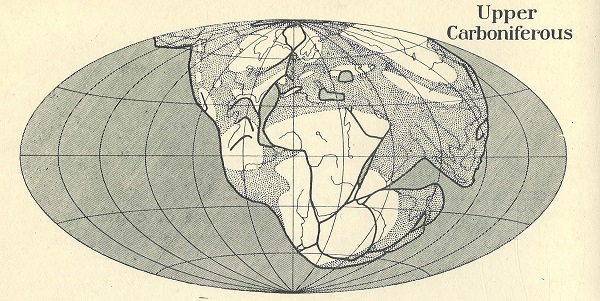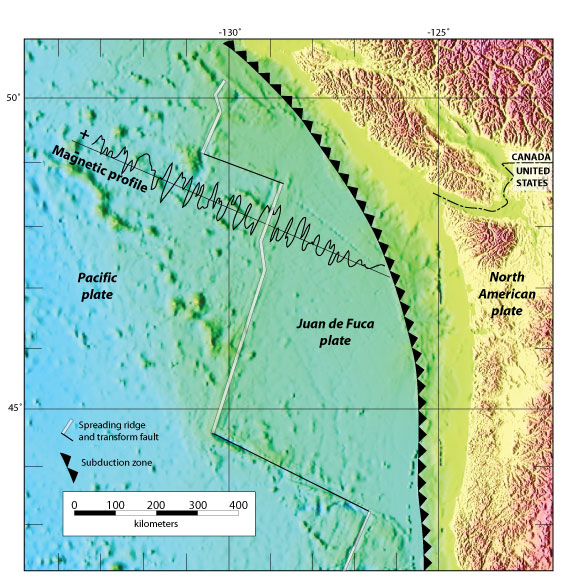How Long Ago Did Scientists Discover Where New Crust Was Continuously Being Made
The Himalayas are often referred to as the "roof of the world" because they host the highest peaks on Earth, most famously Mt. Everest at 8,848 meters above sea level. But the rock that caps Mt. Everest is limestone, a type of rock that forms at the bottom of warm, shallow seas and is composed primarily of fossilized marine creatures, everything from plankton to clams and fish. For years, geologists struggled to explain how the remains of tiny sea organisms could exist at the top of a mountain range.
Into the 1900s, many scientists believed that as Earth cooled after its formation, the planet's surface contracted and wrinkled like the skin of an apple, subjected to the sun and drying out over time. The contraction theory, independently proposed by two prominent scientists in the late 1800s and early 1900s, implied that mountain ranges like the Himalayas were forced up by the wrinkling process. This theory assumed that all of the features on Earth had formed during one cooling event and that the planet was relatively static, changing little as the cooling (and wrinkling) slowed to a halt over millions of years.
Wegener proposes "continental drift"
Alfred Wegener, a German geophysicist and meteorologist, was not satisfied by this explanation. His ideas drew on the widely recognized fact that Africa and South America appeared to fit together like jigsaw puzzle pieces. He collected paleoclimate data, or information about what the climate was like in the geologic past as recorded in rocks, from the continents on both sides of the Atlantic (Figure 1). He recognized that belts of coal, which forms in tropical regions, crossed from North America in Europe and Asia, far north of the modern tropics. He also found evidence that an ice sheet had once advanced from southern Africa and India (see Figure 1), a phenomenon that was impossible to explain in the modern arrangement of the continents.

To explain these data, Wegener proposed the theory of continental drift in his book The Origins of the Continents and the Oceans, published in German in 1915 and in English in 1924 (Wegener, 1924). His theory stated that all of the continents had originally been joined together during the time period called the Carboniferous (now known to be about 300-360 million years ago) in a supercontinent called Pangaea (see Figure 2 for his depiction). By the Eocene (about 50 million years ago), when new fossil species were present that were not as widely distributed, the continents as we know them today had broken apart and were far enough apart that species could not easily migrate from one to the other (see Figure 3 for his depiction).


Driving the drift
When Wegener's book was translated into English, French, Spanish, and Russian in 1924, he was widely ridiculed for his suggestion that the continents had moved. One of the main problems with his theory was that he did not propose a driving mechanism for the motion of the continents. What was the force that moved the continents? Where did it come from? How much force was needed to move a continent?
The driving mechanism, an important key to the continental drift theory, lay out of reach until the 1960s. Wegener had made his claims based on data from the continents, but the oceans cover 70 percent of Earth's surface – a vast area hidden from his view under kilometers of water. But the first and second World Wars brought major technical and scientific developments that allowed scientists to (1) map the ocean floor and (2) measure the magnetism of seafloor rocks in detail. These two sets of data provided geologists with additional evidence for the process of continental drift.
Comprehension Checkpoint
Why wasn't Wegener's theory of continental drift widely accepted at first?
Mapping the ocean floor
Before the 1920s, the crust below the seas was thought to be flat and featureless. During World War I, however, ships equipped with sonar began to produce data about the topography of the seafloor. These sonar maps showed the seafloor to be anything but featureless – instead, the ocean floor hosted valleys deeper than the Grand Canyon, mountain chains rivaling the Andes both in length and height, as well as vast, flat plains.
Most surprising to scientists, a long ridge was found to run down the middle of the Atlantic Ocean, rising 1 to 2 km above the surrounding ocean floor and paralleling the continental coasts on both sides. Similar features, called "mid-ocean ridges" by their discoverers, were mapped in the eastern Pacific Ocean and the western Indian Ocean. Based on the fact that they were parallel to the edges of the continents, the ridges had something to do with continental drift, but what?
In a 1962 paper entitled "History of Ocean Basins," Harry Hess, a geologist at Princeton University, proposed that the mid-ocean ridges marked regions where hot magma rose close to the surface (Hess, 1962). Further, he suggested that the extrusion of magma at the ridges pushed the ocean floor away from the ridges like a conveyor belt. In deep trenches like those found off the coast of South America and Japan, the spreading ocean floor was forced down below the thick continents in regions he called subduction zones. Hess's theory of "seafloor spreading" offered a compelling driving mechanism for Wegener's continental drift, but it needed more proof.
Comprehension Checkpoint
Ocean floors around the world
Seafloor magnetism
The same year that Hess proposed his theory, the US Navy published a report that summarized its findings concerning seafloor magnetism. During World War II, ships dragged magnetometers, which are devices to measure magnetism, in order to locate submarines. The magnetometers were on and measuring at all times while the ships traveled back and forth across the Atlantic and Pacific, and they found a lot more than submarines. When Navy scientists examined the data, they found bands of alternating strong and weak magnetism in the rocks of the seafloor (see Figure 4).

The magnetism was caused by the presence of magnetic minerals in the rocks, primarily one called magnetite, which is common in the basalt that makes up the rocks of the ocean floor. When magma cools and crystallizes, the magnetite crystals are locked into alignment with Earth's magnetic field like the needle of a compass (see our Earth Structure module).
The existence of Earth's magnetic field had been known since ancient times, but only after World War II did scientists realize that the magnetic field is not constant - it fluctuates in intensity and frequently reverses itself. Today we consider the field to have "normal" polarity, and our compass needles point to the north. But at various times in the past, the polarity has been reversed - any compass needles would have instead pointed to the South Pole. This phenomenon of magnetic reversals had previously been observed in continental rocks, and was clearly the case for oceanic rocks as well. The basalt on the ocean floor preserved paleomagnetic reversals: evidence that Earth's magnetic field had flipped from normal to reversed many times throughout geologic history.
Proof of seafloor spreading
In 1963, Fred Vine and Drummond Matthews, two British geologists, joined the topographic map of the Mid-Atlantic Ridge with the symmetric bands of magnetism on the seafloor (Vine and Matthews, 1963). Where the navy ships mapped strong magnetism, rocks showed normal polarity; where they mapped bands of weak magnetism, the rocks showed reversed polarity. The bands not only paralleled the mid-ocean ridges, but were patterned symmetrically about the crest of those ridges (see Figure 5 for an example).

At the crests, the magnetism was strong; therefore, the polarity was normal. But moving in either direction away from the ridge, the magnetism would drop suddenly at about the same distance from the crest – the polarity was reversed. Continue away from the ridge in both directions, and magnetism would suddenly be strong again – back into rocks with normal polarity. The symmetry suggested that magma was rising at the ridges and cooling to lock in the magnetic field at the time, then being pushed away from the ridge in both directions, preserving a record of paleomagnetic reversals and the generation of new crust over time (see Mid-Ocean Ridges concept simulation).
These strongly patterned paleomagnetic reversals recorded on the seafloor provided the necessary proof of Hess's seafloor spreading. Specifically, they proved that new crust was continuously being generated at the mid-ocean ridges, where magma cooled and magnetite crystals "locked in" according to the orientation of Earth's magnetic field at that time. The continents no longer had to "drift" to their present locations – they could be driven by slow and steady magma "conveyor belts" that originated at the mid-ocean ridges.
The work of Hess, Vine, and Matthews resulted in a new map of Earth that highlighted the features of the ocean floor, one that included plate boundaries in addition to coastlines. Plate boundaries could be drawn at mid-oceanic ridges and subduction zones (see Figure 6).

Comprehension Checkpoint
Magnetic stripes on the seafloor are evidence for
Ongoing Evidence for Plate Tectonics
Today, much of the evidence concerning plate tectonics is acquired with satellite technology. Through use of the global positioning system (GPS) and other satellite-based data collection techniques, scientists can directly measure the velocity (or speed and direction of movement) of plates on Earth's surface. Speeds range from 10 to 100 mm per year, confirming the long-held belief that plates move at a slow but constant rate (see our module on Linear Equations for more detail on how to calculate rates of plate movement).
The Himalayas, as it turns out, started forming about 40 million years ago when the Indian Plate collided head-on with the Eurasian Plate, shoving and folding rocks that had formed below sea level into lofty peaks. Because the Indian Plate is still moving northward, the Himalayas are still rising at a rate of about 1 cm per year. We no longer need to invoke a shrinking, wrinkled Earth to explain the marine fossils at the top of these tall mountains; it is the process of plate tectonics that continues to lift seafloor rocks to the sky.
Earth is incredibly dynamic – mountain chains build and erode away, volcanoes erupt and go extinct, seas advance and recede – and these changes are all a result of the processes of plate tectonics. Before Wegener, few had conceived of such a world. His continental drift theory was the first step in the development of plate tectonic theory, the foundation upon which modern geology is built.
Summary
The theory of continental drift was the first step toward plate tectonic theory, which became the foundation upon which modern geology is built. This module describes how the work of Alfred Wegener, Harry Hess, and others led to our understanding of plate tectonics. It explains plate tectonics as the driving force behind ongoing changes on Earth.
Key Concepts
-
The idea that continents can move was proposed by Wegener in 1915 on the basis of fossil evidence, the way in which coastlines seemed to fit together, and other features, but it was not widely accepted at the time.
-
Evidence that led to the development of plate tectonic theory in the 1960s came primarily from new data from the sea floor, including topography and the magnetism of rocks.
-
Seafloor spreading was proposed as a mechanism to drive the movement of the continents on the basis of symmetrical patterns of reversed and normal magnetic rocks on the sea floor.
Source: https://www.visionlearning.com/en/library/Earth-Science/6/Origins-of-Plate-Tectonic-Theory/65
0 Response to "How Long Ago Did Scientists Discover Where New Crust Was Continuously Being Made"
Postar um comentário